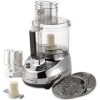Cuisinart MP-14 MP-14N Manual - Page 14
Slicing Meat, And Poultry, Techniques, For Kneading, Yeast Dough, With The, Powerprep, Metal Dough, - limited edition
 |
UPC - 086279005038
View all Cuisinart MP-14 manuals
Add to My Manuals
Save this manual to your list of manuals |
Page 14 highlights
Matchsticks or julienne strips: Process the food twice - 'double slice' it. Insert large fruits or vegetables (potatoes, turnips, zucchini, apples) in the feed tube. Cut pieces to fit the feed tube horizontally from end to end. Apply pressure to the pusher while pressing the PULSE button until the food is sliced. You will get long slices. Remove the slices from the work bowl and reassemble. The slices should be assembled horizontally, with the cut edges facing front and back. Reinsert them in the feed tube, wedging them in tightly. Slice them again. You will obtain long julienne strips. With the optional Square Julienne Disc, you can make square julienne strips in one operation. SLICING MEAT AND POULTRY Cooked meat and poultry: The food must be very cold. If possible, use a piece of food just large enough to fit in the feed tube. To make julienne strips of ham, bologna or luncheon meat, stack slices, then roll or fold them double and stand upright in the feed tube, wedging in as many rolls as possible. This technique works better with square or rectangular pieces than with round ones. Uncooked meat and poultry: Cut the food into pieces to fit the feed tube. Boneless, skinned chicken breasts will usually fit when cut in half crosswise. 13 Wrap the pieces in plastic wrap and put them in the freezer. They are ready to slice when they are easily pierced with the tip of a sharp knife, although semi-frozen and hard to the touch. Remove plastic wrap. Stand them in the feed tube, cut side down, and slice them against the grain, using firm pressure on the pusher. Or lay them flat in the feed tube, as many as will fit, and slice with the grain, using firm pressure. Frankfurters, salami and other sausages: If the sausage is soft, freeze it until hard to the touch but easily pierced with the tip of a sharp knife. Hard sausages need not be frozen. Use the small feed tube if the sausage is thin enough to fit. Otherwise, cut the sausage into pieces to fill the large feed tube completely. Stand the pieces vertically, packing them tightly so they cannot tilt sideways. Firm cheese like Swiss and Cheddar: Cut the cheese into pieces to fit the feed tube. Put it in the freezer until semi-frozen, hard to the touch but easily pierced with the tip of a sharp knife. Stand the pieces in the feed tube and apply light pressure to the pusher. IMPORTANT: Never try to slice soft cheese like mozzarella or hard cheese like parmesan. You may damage the slicing disc or the food processor itself. You can successfully shred most cheeses except soft ones. The exception is mozzarella, which shreds well if thoroughly chilled. Hard cheeses like Parmesan shred well only at room temperature. Therefore, only attempt to slice or shred mozzarella when well chilled, and Parmesan when at room temperature. TECHNIQUES FOR KNEADING YEAST DOUGH WITH THE POWERPREP® METAL DOUGH BLADE The Limited Edition Metal™ Food Processor is designed to mix and knead dough in a fraction of the time it takes to do it by hand.You will get perfect results every time if you follow these directions. NEVER TRY TO PROCESS DOUGH THAT IS TOO STIFF TO KNEAD COMFORTABLY BY HAND. There are two general types of yeast dough. Typical bread dough is made with a flour mix that contains at least 50% white flour. It is uniformly soft, pliable and slightly sticky when properly kneaded. It always cleans the inside of the work bowl completely when properly kneaded. Typical sweet dough contains a higher proportion of sugar, butter and/or eggs than typical bread dough. It is rich and sticky and it does not clean the inside of the work bowl.















